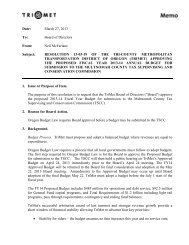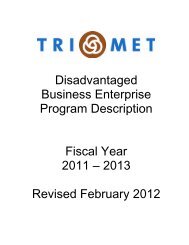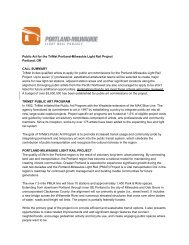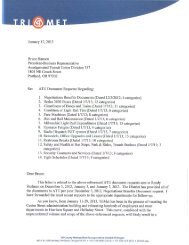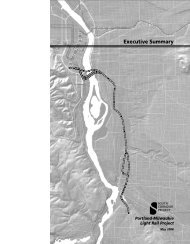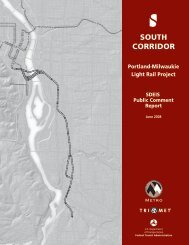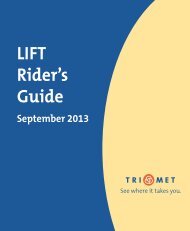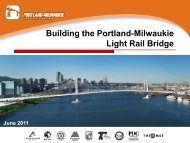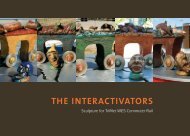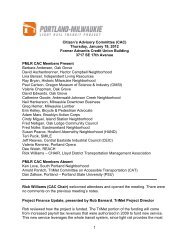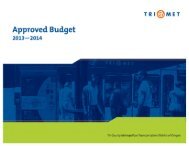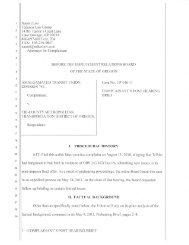Public Transit in Portland: a History - TriMet
Public Transit in Portland: a History - TriMet
Public Transit in Portland: a History - TriMet
Create successful ePaper yourself
Turn your PDF publications into a flip-book with our unique Google optimized e-Paper software.
Travel<strong>in</strong>g through time<br />
Dear Reader,<br />
<strong>Transit</strong> plays a critical role <strong>in</strong> provid<strong>in</strong>g options for travel<strong>in</strong>g throughout the region.<br />
It connects people to work, school, recreational dest<strong>in</strong>ations and essential services.<br />
It’s not just a commuter service. It’s a community asset. And the benefits extend far<br />
beyond those who ride.<br />
<strong>TriMet</strong>’s transit system is recognized as a national leader for its connection to<br />
land use. By l<strong>in</strong>k<strong>in</strong>g land-use plann<strong>in</strong>g and transit, we have helped create livable<br />
communities, vibrant neighborhoods and provide alternatives to driv<strong>in</strong>g.<br />
<strong>Transit</strong> is also a catalyst for economic development. More than $10 billion <strong>in</strong><br />
transit-oriented development has occurred with<strong>in</strong> walk<strong>in</strong>g distance of MAX light rail<br />
stations s<strong>in</strong>ce the decision to build <strong>in</strong> 1980. Developers like the<br />
permanence of rail when <strong>in</strong>vest<strong>in</strong>g <strong>in</strong> projects.<br />
<strong>Transit</strong> is also valued by the community. Most of our riders—81<br />
percent—are choice riders. They have a car available or choose<br />
not to own one so they can ride <strong>TriMet</strong>. With more than 315,000<br />
trips taken each weekday on our buses, MAX Light Rail and WES<br />
Commuter Rail, we elim<strong>in</strong>ate 65 million annual car trips. That<br />
eases traffic congestion and helps keep our air clean. <strong>TriMet</strong><br />
carries more people than any other U.S. transit system our size.<br />
Our many <strong>in</strong>novations have drawn the attention of government<br />
leaders, planners, transit providers and transit users from around<br />
the world.<br />
We didn’t start out that way. When <strong>TriMet</strong> was created <strong>in</strong> 1969,<br />
the former transit agency was fac<strong>in</strong>g bankruptcy, with dw<strong>in</strong>dl<strong>in</strong>g<br />
ridership and little community support. Over the years, we’ve<br />
built partnerships with government agencies, key stakeholders,<br />
bus<strong>in</strong>esses and the public. This region has come together and created a shared<br />
vision that ensures transit cont<strong>in</strong>ues to play a lead<strong>in</strong>g role <strong>in</strong> this region’s livability<br />
and growth.<br />
As you look through this publication, you’ll see the events that have formed the<br />
history of public transportation <strong>in</strong> the <strong>Portland</strong> area. You’ll also see how far we’ve<br />
come from our early days of horse-drawn streetcars to today with 79 bus l<strong>in</strong>es, a<br />
52-mile light rail network and the state’s first commuter rail l<strong>in</strong>e, and where we’re<br />
headed next.<br />
Neil McFarlane<br />
General Manager<br />
<strong>TriMet</strong>



